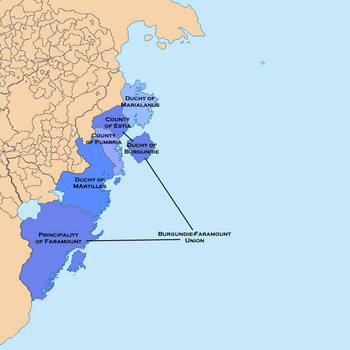Principality of Faramount
This article is a work-in-progress because it is incomplete and pending further input from an author. Note: The contents of this article are not considered canonical and may be inaccurate. Please comment on this article's talk page to share your input, comments and questions. |
| This article is a stub. You can help IxWiki by expanding it. |
Principality of Faramount | |||||||||
|---|---|---|---|---|---|---|---|---|---|
| 1568-1853 | |||||||||
|
Flag | |||||||||
 Map of Faramount and the other coastal Dericanian states in 1854, Faramount | |||||||||
Common languages | Latin | ||||||||
| Religion | Catholic Church | ||||||||
| Demonym(s) | Faramountesc | ||||||||
| Government | Absolute monarchy | ||||||||
| Prince | |||||||||
| Historical era | Early modern period | ||||||||
| |||||||||
| Today part of | |||||||||
Politics and government
Formed in the midst of the Great Confessional War, Faramount embarked on a path that sought to reconcile its historical monarchical legacy inherited from Gassavelia with the evolving demands for political participation, especially after the Cousin's War of the early 17th century, when it established a constitutional monarch in 1635. This approach to governance allowed for some level of political participation for landowners and some city-dwellers (guild members) while retaining much of the autocratic powers of the prince. Faramount's political ethos emphasized a nuanced balance, wherein the prince played a pivotal role in steering the principality's course, but with guidance and consultation from the Concordata, the elected representative body.
Concordata
Members of the Concordata were selected through a combination of hereditary and merit-based systems. Certain seats were reserved for individuals from noble families, preserving a link to Faramount's historical aristocracy. Another portion of seats was allocated through regional elections, where representatives were chosen based on their contributions to the principality's economic, cultural, or intellectual spheres and was a direct result of the Cousin's War. The Concordata served as a vital advisory and legislative body, providing counsel to the prince on matters of governance, policy, and regional affairs. Members represented not only their respective constituencies but also brought forth expertise in areas such as trade, culture, and defense. The council deliberated on proposed laws, taxation, and the foreign policy to include war.
Within the Concordata, specific councils emerged, each specializing in distinct areas of governance. These councils included an Economic Council, responsible for advising on trade and commerce; a Cultural Council, focused on matters related to royal patronage of arts and education; and a Defense Council, providing insights on military strategies and national security. The prince, informed by these specialized councils, could make the ultimate decisions which had no recourse until after the Age of Enlightenment, circa 1760s, after which the relationship was made more reciprocal.
Culture
The cultural origins of Faramount, deeply rooted in its Battganuuri heritage, underwent a transformative fusion with the Occidental mores prevalent within the Holy Levantine Empire. As descendants of the Battganuuri Ashrafin dynasty, the ruling class of Gassavelia found themselves at the crossroads of diverse cultural influences. The principality's strategic location in southeastern Levantia facilitated a nuanced intermingling of Battganuuri traditions with the Occidental ethos predominant in the empire.
In the realm of religion, the Nestorian Christianity practiced by the Ashrafinids gradually underwent a syncretic evolution as Gassavelian integrated into the Holy Levantine Empire. The principality's ruling class navigated a delicate path, preserving elements of Nestorian Christianity while adapting to the dominant Catholicism of the empire. Over time, this process of religious assimilation resulted in a unique Gassavelian that harmonized Nestorian traditions with Catholic doctrines, creating a distinct religious identity within the broader Levantine context.
This cultural amalgamation extended beyond religious practices, permeating various facets of Gassavelian and later Faramountesc life. Battganuuri linguistic and artistic elements found resonance alongside Occidental influences, leading to a cultural admixture that seamlessly blended Battganuuri and Levantine aesthetics. The Ashrafinid ruling class, while maintaining certain exclusivities, also embraced cultural exchanges with the diverse populations under their rule, fostering a syncretic ethos that transcended religious boundaries.
As Gassavelia transitioned into Faramount, this cultural synthesis became an integral part of the principality's identity. The Battganuuri origins, now intricately woven into the Occidental fabric of the Holy Levantine Empire, created a new and unique Gassavelian culture. The inherited cultural legacy of Faramount reflected a harmonious blend of Battganuuri and Occidental influences, shaped by centuries of proximity and adaptation.
